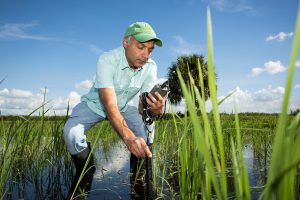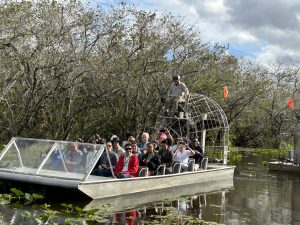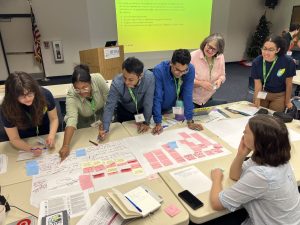
Phosphorus is an essential nutrient for food security and human survival, and it is an element that cannot be replenished.
That is why using phosphorus efficiently is essential and the focus of a national research effort led by leading scientists across the country to promote phosphorous sustainability.
University of Florida scientists recently led a critical next step in that national effort with funding from the National Science Foundation-Science and Technology Center (NSF-STC). UF researchers hosted a think tank in South Florida with 37 other scientists from across the country, serving as part of the Science and Technologies for Phosphorus Sustainability (STEPS) Center.
“STEPS is a convergence research community of diverse and leading scientists, dealing with complex challenges in phosphorus sustainability by integrating disciplinary contributions across the physical, life, social and economic sciences,” said Jehangir Bhadha, an associate professor of soil, water, and ecosystem sciences at the UF Institute of Food and Agricultural Sciences Everglades Research and Education Center (UF/IFAS EREC). “With the growing global population and available farmland decreasing, there’s a pressing need for approaches to reduce human dependence on mined phosphates.”
Bhadha and a team of UF/IFAS researchers including, Sandra Guzmán, Elise Morrison, Jonathan Judy, Kelly Morgan, and Juan Nino were tapped to join the national STEPS center, with eight other universities.
Over a three-day period, the STEPS members toured South Florida, aiming to learn about its unique ecosystem as it relates to phosphorus management.
 The retreat had four objectives:
The retreat had four objectives:
- Bring STEPS researchers together to strengthen collaborative bonds and share knowledge to advance specific STEPS projects and/or initiatives.
- Harness the power of the South Florida aquatic ecosystem to guide problem- solving.
- Deepen the team’s shared understanding of existing South Florida aquatic ecosystem knowledge, data, research infrastructures and stakeholders.
- Identify critical questions and barriers to understanding and affecting phosphorus sustainability using a specific case study.
The first day involved a visit to the South Florida Water Management District (SFWMD) office in West Palm Beach, where the group attended a presentation by Jill King and Susan Mason on SFWMD Stormwater Treatment Areas (STAs) and how they’re used to mitigate phosphorus from agricultural and urban runoff.
The STAs span nearly 96.5 square miles, making them the largest system of treatment wetlands in the world, said Bhadha, a co-organizer of the tour.
“The way the system works is by naturally treating the phosphorus within these wetlands, where different communities of submerged and emergent vegetation take up phosphorus from the water, and the sediments sequester litter,” he said. “Low phosphorus concentration water is then delivered farther south to an area known as the Everglades Protection Area.”
The group also visited one of five treatment wetlands known as Stormwater Treatment Area 1 West (STA-1West) to witness the workings of these wetlands. The next stop was a field visit to the Everglades Agricultural Area in Belle Glade, where the group talked with farm manager Elliott Rounds of the Sugar Cane Growers Cooperative and Matthew VanWeelden, an agronomic crops UF/IFAS Extension agent at EREC.
There, they learned about the Best Management Practice program and its success in reducing phosphorus loads from agricultural lands, said Bhadha. The final stop of the first day was an airboat excursion in Everglades National Park, where the group witnessed the natural ecosystem up close, including its unique flora and fauna. They also earned from local park rangers about its ecosystem services.

“After soaking in all this information, the second day was dedicated to identifying key questions and barriers affecting phosphorus sustainability within the South Florida aquatic ecosystem through group discussion and brainstorming activities,” said Bhadha.
This led to a list of outcomes that STEPS plans to pursue over the next couple of years, including prospective articles, future proposals, treatment technology interventions and social-behavioral assessments.
“Our goal was to provide our researchers with the tools and connections needed to facilitate effective problem-solving strategies for sustainable phosphorus management across the South Florida ecosystem,” said Alison Deviney, a STEPS postdoctoral scholar at North Carolina State University, who helped develop the knowledge-mapping workshop.
Led by North Carolina State University, STEPS is headquartered on N.C. State’s Centennial Campus. It brings together top scientists from different fields to tackle the phosphorus sustainability. Researchers combine knowledge from various sciences, including physics, biology, and economics. The program is funded by an initial, five-year, $25 million grant that is renewable for an additional five years. Through this project, scientists will work to reduce dependence on mined phosphates and the amount of phosphorus that leaches into soil and water.
Their goal is ambitious: Within 25 years, they want to cut our reliance on mined phosphates by 25% and decrease phosphorus losses to soil and water by the same amount.
###
By Lourdes Mederos, rodriguezl@ufl.edu
ABOUT UF/IFAS
The mission of the University of Florida Institute of Food and Agricultural Sciences (UF/IFAS) is to develop knowledge relevant to agricultural, human and natural resources and to make that knowledge available to sustain and enhance the quality of human life. With more than a dozen research facilities, 67 county Extension offices, and award-winning students and faculty in the UF College of Agricultural and Life Sciences, UF/IFAS brings science-based solutions to the state’s agricultural and natural resources industries, and all Florida residents.
WHY FOOD IS OUR MIDDLE NAME
Feeding a hungry world takes effort. Nearly everything we do comes back to food: from growing it and getting it to consumers, to conserving natural resources and supporting agricultural efforts. Explore all the reasons why at ifas.ufl.edu/food or follow #FoodIsOurMiddleName.
 4
4
